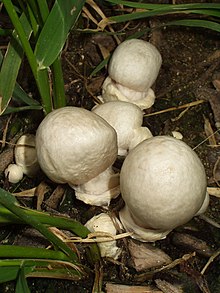Destroying angel

The name destroying angel applies to several similar, closely related species of deadly all-white mushrooms in the genus Amanita.[1] They are Amanita virosa in Europe and A. bisporigera and A. ocreata in eastern and western North America, respectively.[1] Another European species of Amanita referred to as the destroying angel, Amanita verna - also referred to as the 'Fool's mushroom' - was first described in France in 1780.[2]
Destroying angels are among the most toxic known mushrooms; both they and the closely related death caps (A. phalloides) contain amatoxins.[1]
Description
Destroying angels are characterized by having a white stalk and gills. The cap can be pure white, or white at the edge and yellowish, pinkish, or tan at the center. It has a partial veil, or ring (annulus) circling the upper stalk, and the gills are "free", not attached to the stalk. Perhaps the most telltale of the features is the presence of a volva, or universal veil, so called because it is a membrane that encapsulates the entire mushroom, rather like an egg, when it is very young. This structure breaks as the young mushroom expands, leaving parts that can be found at the base of the stalk as a boot or cuplike structure, and there may be patches of removable material on the cap surface. This combination of features, all found together in the same mushroom, is the hallmark of the family. While other families may have any one or two of these features, none has them all. The cap is usually about 5–12 centimetres (2–4+1⁄2 inches) across; the stipe is usually 7.5–20 cm (3–8 in) long and about 0.5–2 cm (1⁄4–3⁄4 in) thick. They are found singly or in small groups.[citation needed]
Destroying angels can be mistaken for edible fungi such as the button mushroom, meadow mushroom, or the horse mushroom. Young destroying angels that are still enclosed in their universal veil can be mistaken for puffballs, but slicing them in half longitudinally will reveal internal mushroom structures. This is the basis for the common recommendation to slice in half all puffball-like mushrooms picked when mushroom hunting. Mushroom hunters recommend that people know how to recognize both the death cap and the destroying angel in all of their forms before collecting any white gilled mushroom for consumption.[citation needed]
Distribution and habitat

All Amanita species form ectomycorrhizal relationships with the roots of certain trees. Thus, destroying angels grow in or near the edges of woodlands. They can also be found on lawns or grassy meadows near trees or shrubs. Several species called destroying angel are found all over the world.[3] Amanita bisporigera is associated with oaks and conifers.[4]
Toxicity
The destroying angel (Amanita bisporigera) and the death cap (Amanita phalloides) account for the overwhelming majority of deaths due to mushroom poisoning. The toxin responsible for this is amatoxin, which inhibits RNA polymerase II and III. Symptoms do not appear for 5 to 24 hours, by which time the toxins may already be absorbed and the damage (destruction of liver and kidney tissues) is irreversible. As little as half a mushroom cap can be fatal if the victim is not treated quickly enough. The symptoms include vomiting, cramps, delirium, convulsions, and diarrhea. In one study, people who had ingested the toxin were treated with "fluid and electrolyte replacement, oral activated charcoal and lactulose, IV penicillin, combined hemodialysis and hemoperfusion in two 8-hour sessions", some with "IV thioctic acid, others IV silibinin" and all received a "special diet". It was concluded that "...intensive combined treatment applied in these cases is effective in relieving patients with both moderate and severe amanitin poisoning."[5]
Physicians have had success in treatment of amatoxin poisoning using "anti-hepatotoxic" compounds from the milk thistle, Silybum marianum. A crude extract of flavolignans from S. marianum seeds, called silymarin (trade name Legalon) has proven useful in amatoxin poisoning cases. In a trial of one of the flavolignans silybin, in 60 patients poisoned by amatoxin-containing Amanita species, there were no deaths. (see Der Marderosian & Liberti 1988 and Foster 1991 for a summary of this work).[6]
See also
References
- ^ a b c Hallen, H. E.; Luo, H.; Scott-Craig, J. S.; Walton, J. D. (2007). "Gene family encoding the major toxins of lethal Amanita mushrooms". Proceedings of the National Academy of Sciences. 104 (48): 19097–19101. doi:10.1073/pnas.0707340104. PMC 2141914. PMID 18025465.
- ^ Bulliard JBF. (1780). Herbier de la France. Vol 1 (in French). Vol. 97–144. Paris, France: P.F. Didot. pp. 97–144, plate 108.
- ^ Durand, François; Valla, Dominique (2013), "Mushroom Poisoning", Drug-Induced Liver Disease, Elsevier, pp. 621–629, doi:10.1016/b978-0-12-387817-5.00034-0, ISBN 978-0-12-387817-5, retrieved 2022-06-21
- ^ Sturgeon, Walt (2018). Appalachian mushrooms : a field guide. Athens, Ohio. p. 10. ISBN 9780821423257.
{{cite book}}: CS1 maint: location missing publisher (link) - ^ Sabeel, A.I.; Kurkus J.; Lindholm T. (September 1995). "Intensive hemodialysis and hemoperfusion treatment of Amanita mushroom poisoning". Mycopathologia. 131 (2): 107–114. doi:10.1007/BF01102888. PMID 8532053. S2CID 23001126.
- ^ Ott, Jonathan (1993). Pharmacotheon. Kennewicker, WA: Natural Product Co. p. 354. ISBN 0-9614234-2-0.
External links
- Amanita bisporigera: the destroying angel
- Experience: I nearly died after eating wild mushrooms The Guardian 13 November 2010
- I survived the “Destroying Angel” Cornell Mushroom Blog 22 November, 2006
- CS1: long volume value
- CS1 French-language sources (fr)
- CS1 maint: location missing publisher
- Articles with short description
- Short description matches Wikidata
- All articles with unsourced statements
- Articles with unsourced statements from April 2010
- Amanita
- Hepatotoxins
- Poisonous fungi
- Deadly fungi
- Fungus common names

